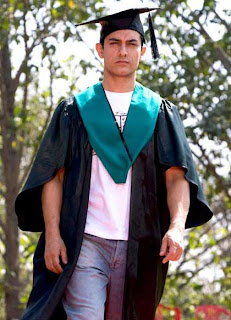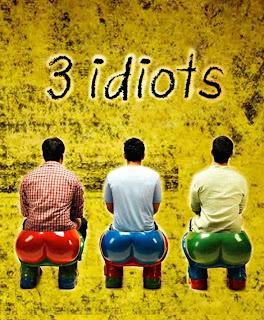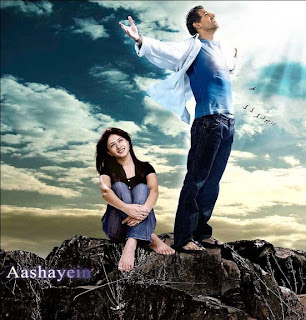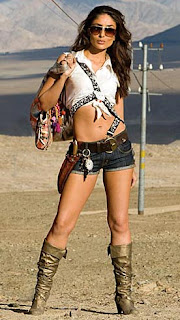[ItzToday.com] Aamir Khan has kept 3 Idiot's Rancho costume |
- Aamir Khan has kept 3 Idiot's Rancho costume
- '3 Idiots' soon in Tamil, Telugu: Raju Hirani
- Hindi Movie "Aashayein" Review
- Hot Kareena Kapoor Interview: I want roles with acting opportunity
- Bhojpuri cinema on the path of success
| Aamir Khan has kept 3 Idiot's Rancho costume Posted: 27 Aug 2010 10:28 PM PDT  Aamir Khan has confessed he keeps the costumes of all the characters he plays in films, even the clapboards. Aamir Khan has confessed he keeps the costumes of all the characters he plays in films, even the clapboards.Aamir has kept the costumes of Rancho, the character he essayed in the superhit '3 Idiots', as well as the clapboards, as he has done for all his films. "You know I keep the clapboards of all my films. On the last day of the shoot, I collect it, even the costumes," Aamir told reporters at the DVD launch of "3 Idiots" at Grand Hyatt here Friday. Asked if he would produce Marathi films, he said: "I would be happy to produce Marathi films. The story and script should touch my heart. Language is not the problem. I would love to produce Gujarati, Bhojpuri. The beauty of our country is that we have around 22 languages and in every language we make films and there are television channels in every language, which you won't find in anywhere else. I would be happy to make films in other language also." The superstar said he wishes he could have shown "3 Idiots' to his favourite directors -Guru Dutt, Mehboob and Raj Kapoor. "Guru Dutt, Mehboobji and Raj Kapoor, I would have liked them to see this film (3idiots)," Aamir said. In the last 10 years, the actor has give some major hits like "Lagaan: Once Upon a Time in India" (2001), "Dil Chahta Hai" (2001), "Rang De Basanti" (2006), "Fanaa" (2006), "Ghajini" (2008). The actor maintains that every film is a collective effort and the key person is the director of the film. "One thing that all should remember is that the main thing of a film is the collective effort, and the most important person of a film is the director. Till now if so many of my films have become successful, its bigger share of credit goes to the director. "Like in '3 Idiots' Raju (Rajkumar Hirani), Abhijat (Joshi) have a huge contribution, after that we all have put in our best, that's why you liked '3 Idiots' so much. So I don't solely take the credit behind the success of the film, it's a collective effort of every single person associated with the film." |
| '3 Idiots' soon in Tamil, Telugu: Raju Hirani Posted: 27 Aug 2010 10:21 PM PDT  Director Raju Hirani has revealed that his "3 Idiots", which created history by becoming the all-time highest grosser, is getting remade in Tamil and Telugu. Director Raju Hirani has revealed that his "3 Idiots", which created history by becoming the all-time highest grosser, is getting remade in Tamil and Telugu."The film is being remade in Tamil and Telegu. I don't have any idea on who are playing the lead there. I think they are in the process of casting," said Raju at the DVD launch of the film here. Ruju maintained he is not planning any sequel of "3 Idiots". "I am not thinking of any sequel to '3 Idiots', unless I hit upon any great idea which could be a sequel, but nothing as of now," Raju told IANS. Raju is getting ready with the third instalment of "Munnabhai..." "I am of course working on the script of 'Munnabhai...', I am also working on another script. Can't say which would come first," said Raju. |
| Hindi Movie "Aashayein" Review Posted: 27 Aug 2010 10:06 PM PDT  Film: "Aashayein"; Starring: John Abraham, Prateeksha Lonkar, Ashwin Chaitale; Film: "Aashayein"; Starring: John Abraham, Prateeksha Lonkar, Ashwin Chaitale;Written & Directed by Nagesh Kukunoor; Rating: *** ½ This is a film about coping with dying. But that's not what makes it such a special experience. It's the writer-director's profound understanding of human nature that furnishes the simple story with a lucidity and coherence even when the protagonist's mind is so numbed by physical pain he can barely think straight. "Aashayein" is structured as a journey from a bright delusory light into a place where the radiance comes from a consciousness of why mortality is not to be feared. In John Abraham's eyes are mapped the entire history of the human heart, its follies and foibles as it struggles to make coherent the indecipherable logistics that define our journey across that bridge which everyone crosses from this world to the next. As that very fine actress Prateeksha Lonkar (a Kukunoor favourite) says, "The only difference between the healthy and the ill is that the former don't know when they are dying and the latter do." Between that state of blissful oblivion where we all think life is forever (and a day) and that one moment when our delusions come crashing down, there resides some very fine cinema. Hrishikesh Mukherjee's "Anand" where Rajesh Khanna smiled his way through that wobbly bridge taking us to the next world, is an interesting reference point in "Aashayein". I also thought of the actress Supriya Choudhary shouting into the dispassionate mists in the mountains, "I want to live". The echoes reverberate all the way to Kukunoor's heartwarming, funny and elegiac exposition on the truth that lies on the other side of that illusory mountain we call life. Kukunoor pays a homage to life per se, and life as we know in the movies about death. Even in the most poignant places in the art Kukunoor ferrets out some humour. When John's lovely girlfriend (Sonal Sehgal) hunts him down in his exilic place of the dying, John quips, "So you are not going to behave like one of those heroines in films who dumps the dying hero?" The fantasy element creeps into the hospice (yes, that's the spotless space that the story inhabits unostentatiously) with the least amount of fuss. There's a little boy (the bright and expressive Ashwin Chitale) who weaves mystical tales borrowed from the comic books for the desperate and the dying. Here Kukunoor brings in an element of rakish adventure borrowed from the edgy hijinks of Indiana Jones. Who says money can't buy love? John uses bundles of cash to bring a smile to these doomed lives. When he doubles up with pain in womb-like postures of helplessness we feel his pain. John in Harrison Ford's hat and whip cuts a starry figure. He has never been more fetchingly photographed. John's smile reaches his eyes, makes its way to his heart and then to ours. This film opens new doors in John's histrionic abilities. It's a performance that heals and nurtures. John's finest moments are reserved for a hot-tempered sharp-tongued 17-year-old girl on a wheelchair, played with intuitive warmth by Anaitha Nayar. He guides the relationship between these two unlikely comrades of unwellness with brilliant restrain and candour. She wants him to make love. He does with his eyes using his unshed tears as lyrical lubricant. Here is a performance that defines the character through immense measures of unspoken anguish. Rajesh Khanna in "Anand"? Nope. John pitches his performance at a more wry and cynical world where true feelings are often smothered in worldly sprints across a wounded civilization. This is unarguably Kukunoor's most sensitive and moving work since "Iqbal". We often find little sobs pounding at the base of our stomachs. Not all the characters or situations are fully formed and fructified. But even the partly-realized truths in "Aashayein" convey more common sense and uncommon affection for life than the "entertainers" of today's cinema where laughter is generated through cracks in places very far removed from the heart. This one takes us straight to the heart. |
| Hot Kareena Kapoor Interview: I want roles with acting opportunity Posted: 27 Aug 2010 09:59 PM PDT  Bollywood star actress Kareena Kapoor feels she has managed to strike the right balance between commercial and meaningful cinema. Hailing from an illustrious film family, she says she can't do films where she only has to dance around trees. Bollywood star actress Kareena Kapoor feels she has managed to strike the right balance between commercial and meaningful cinema. Hailing from an illustrious film family, she says she can't do films where she only has to dance around trees."I enjoy acting. Acting is in my blood, it is in my genes, it is in my DNA and you can see that on screen I like doing different roles. I can't do just those films where I am looking pretty and sing and dance around trees. I want to act," Kareena told IANS in an interview. The actress considers her debut film "Refugee" (2000) a special film. " 'Refugee' was a very special film because I always wanted to prove myself as an actress and not to be known just as a glam doll. There are films like 'Refugee', 'Chameli', 'Omkara', 'Jab We Met', '3 Idiots' and 'Kurbaan'; they all have been very different. "I don't think any other actress has been able to do such a variety of roles. So the journey, I think, has been colourful," said Kareena, 29. Nine years after "Kabhi Khushi Kabhie Gham" (2001), where she played Kajol's younger sister, Kareena has teamed up with Kajol in Sidharth Malhotra's directorial debut "We Are Family". She is elated to share the same frame with the senior actress. "I think it's an exciting challenge to be working with Kajol. In 'Kabhi Khushi Kabhie Gaam' we didn't have too many scenes together, but in this film we are both in the same frame. We both live in the same house, have equally powerful roles; in fact, mine is the most complex and complicated part. It's very easy to be emotional and gain sympathy but very difficult to win over the sympathy and I hope I could achieve that," she said. Releasing Sep 3, "We Are Family" is the Hindi adaptation of Hollywood hit "Stepmom" (1998). Arjun Rampal plays what Ed Harris did in the original, while Kajol steps into Susan Sarandon's shoes as as a divorced mother. Kareena plays the same role that Julia Roberts did, but in her own style. "I am absolutely honoured that Karan (producer Karan Johar) and Sidharth thought that I could do the Julia Roberts role because to me she is the finest actress," said the actress who feels the adaptation could have been more contemporary. "It's a very desi film. I think it should have been made more contemporary. Indian audiences are ready for that. It's about the journey of two women. They start off with hating each other and due to unforeseen circumstances they end up loving each other." While working with Kajol, Kareena observed that her co-star was quite similar to her sister Karisma when it comes to their child. "Kajol is a hands-on mother. I have seen Karisma. Both Kajol and Karisma, I don't know if it's the trait of that generation, are just there with their children," said Kareena. Asked how it would have been if Karisma had played Kajol's role, she quipped, "Oh god! She can't do that because we can't marry the same man. No way." There are three child stars - Aanchal Munjal, Nominath Ginsburg and Diya Sonecha - in the film, but Kareena didn't have to handle them. She is all praise for their professional behaviour on the sets though. "In the film, I didn't have to be with the kids because they had their mother (Kajol). The children were really lovely, they didn't get impatient. They were acting like adults, not like children," said Kareena. |
| Bhojpuri cinema on the path of success Posted: 27 Aug 2010 09:53 PM PDT Under the big tree called Bollywood, the Bhojpuri film industry has been steadily taking root. While the mega Hindi film industry struggles to profit from its releases, its fledgling cousin has been growing steadily, doubling its output from 50 films four years ago to 100 films annually, and making money too. Industry insiders say films in the Hindi dialect can do even better if the government extends support. "We now release about 100 films in a year. The average money spent yearly on Bhojpuri films is close to Rs.100 crore and the gross collection is about Rs.125 crore every year," Ranjan Sinha, spokesperson for the Bihar Jharkhand Motion Picture Association, told IANS on phone from Patna. "Even if a film doesn't work, the producer doesn't have to bear a big loss. His loss is not more than Rs.10 lakh to 15 lakh." The turning point, he said, came with the 2003 blockbuster "Sasura Bada Paisa Wala" with superstar Manoj Tiwari, sometimes compared to Rajnikanth. The film was made at a budget of Rs.35 lakh to 40 lakh and made massive profits all over India. "The film did a business of Rs.1.90 crore in Bihar, Rs.1.25 crore in Uttar Pradesh. Its all-India collections were Rs.4.5 crore," said Sinha. The biggest consumer of Bhojpuri films are Bihar, Uttar Pradesh as well as Mumbai, which has sizeable migrant population from the Hindi belt. Bhojpuri films also get good audiences in West Bengal, Punjab and Gujarat, which are also home to migrants from Uttar Pradesh and Bihar. "There are 372 cinema halls in Bihar and Jharkhand; of them, 180 run Bhojpuri films," said Sinha. "There are 32 centres in Mumbai where we run Bhojpuri films. After Bihar and Uttar Pradesh, Mumbai is the biggest market for Bhojpuri films. The major collection comes from Super Cinema at Grant Road and Navrang Theatre in Andheri - Bhojpuri films earn about Rs.300,000 to Rs.400,000 per week at these centres," added Shashikant Singh, a Mumbai-based film publicist. Costs are low. Most Bhojpuri films, costing about Rs.30 lakh to 45 lakh unless a big star like Tiwari is involved, are shot in small Bihar towns like Buxor and Gaya. Bhojpuri heartthrob Tiwari charges somewhere between Rs.50 lakh and 60 lakh. Dinesh Lal Yadav Nirahua, Pawan Singh, Ravi Kishen and Vinay Anand round up the top five stars list. Among the actresses, Rinku Ghosh and Mona Lisa are most sought after. Anara Gupta, Pakhi Hegde and Rani Chatterjee are the others in the top five list. According to Tiwari, the picture would get rosier if the government steps in. "It is indeed a growing industry, but our growth is slow. We could be five times better if the government supports us. Bhojpuri is not included in the Eighth Schedule of the constitution and so Bhojpuri films aren't bought by Doordarshan," he told IANS. "As we are not listed in the Eighth Schedule, we are not eligible for National Awards also," he added. "The sad part is that people from Bihar and Uttar Pradesh who represent us in parliament are not thinking about our culture," said Tiwari, who contested elections as a Samajwadi Party candidate for the Gorakhpur Lok Sabha seat and lost. The future is bright but could be better if filmmakers spread the net wider to lure middle class audiences, instead of just targeting the front benchers. "They should avoid using cheap words in the song and they should also try to come out with original scripts," said Sinha. Manoj agreed: "Till now, the viewer for a Bhojpuri movie is from the lower strata of life. The middle classes don't come to see our films." Manoj, whose "Mard No.1" will have an international release, feels that the government should try to release Bhojpuri films in multiplexes at subsidised rates to lure the affluent movie audience. "Marathi films are being shown in Mumbai multiplexes at subsidised rates, something similar should be done for Bhojpuri films," said Manoj. Bhojpuri cinema had an interesting beginning in the 1950s following an encounter between India's first Bihar-born president Rajendra Prasad and Mumbai-based character actor Nazir Hussain. The president, upon realising that Hussain was a native of Ghazipur in eastern Uttar Pradesh, began to address him in his mother tongue Bhojpuri. The conversation soon veered to movies and Rajendra Prasad asked Hussain, "Why don't you make a film in Bhojpuri?". According to a book "Cinema Bhojpuri" by Avijit Ghosh, the encouragement from the president resulted in "Ganga Maiya Tobe Pyari Chadhaibo". |
| You are subscribed to email updates from Hindi Movies To stop receiving these emails, you may unsubscribe now. | Email delivery powered by Google |
| Google Inc., 20 West Kinzie, Chicago IL USA 60610 | |

0 comments:
Post a Comment